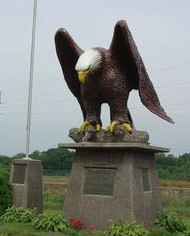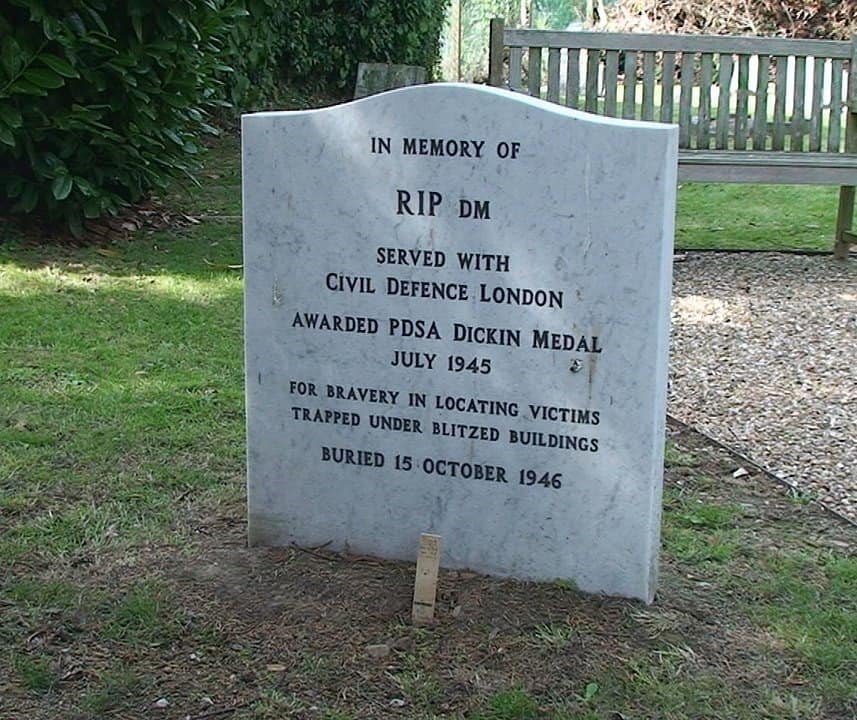War is heck but it doesn’t scare off some of the bravest and most famous war animals on the planet. From pig to duck, many a creature has stood alongside their fellow soldiers in combat. Here are 10 of the bravest warriors and heroes who fought the hard fight, true famous war animals.
#1 Warrior
Captain Jack Seely rode his horse, Warrior, during World War I. The duo were companions throughout the conflict, traveling with the British Expeditionary Force to France (1914) and returning home in the cold winter of 1918.
Together, they saw the war’s fiercest combat. Warrior led the Canadian Cavalry Brigade in the war’s final major charge at Moreul Wood in 1918. A quarter of the regiment and half the horses were casualties. Somehow, Warrior walked away without a scratch. They call him “the horse the Germans could not kill.”
A century after World War I, Warrior was posthumously given an honorary Dickin Medal, representing every animal that served. The Dickin Medal recognizes acts of devotion and bravery by animals during periods of conflict or war.
#2 Tirpitz
Tirpitz was a pig and had the honor of being the mascot of the SMS Dresden.
It’s World War I and the mascot gets left aboard the sinking German cruiser. She should’ve been a casualty of war but miraculously escaped. The crew of a nearby ship, the HMS Glasgow, sees the floundering Tirpitz. A sailor dives in and rescues the pig.
Tirpitz gets awarded a fake Iron Cross, a great German military honor. She’s applauded for remaining behind when the rest of the crew abandoned the ship.
Tirpitz stays with the Glasgow for the remainder of her military career. In 1916, she retires to Portsmouth’s Whale Island Gunnery School. In 1919, the war hero’s auctioned off, raising $2,366.67 (counting for inflation) for the British Red Cross. Her remains become food while her head’s mounted. To this day, that head remains on display at the Imperial War Museum, recognizing Tirpitz as one of the most famous war animals.
#3 Judy
Judy was an English pointer. A purebred, she was a Royal Navy adoption. The HMS Grasshopper, on which Judy was aboard, got torpedoed during World War II. The crew along with their mascot found themselves captured. The Japanese imprisoned them.
During the ordeal, Frank Williams, an aircraftman, cared for Judy. Throughout their imprisonment, Williams shared his rations with Judy. He pretty much saved her life by somehow getting the dog registered as an official prisoner of war. A natural sight at the camp was Judy growling and barking to distract guards beating on Americans. She also snuck off and brought food back to starving POWs.
Freed in 1945, Judy received the Dickin Medal for “magnificent courage and endurance in Japanese prison camps, which helped to maintain morale among her fellow prisoners and also for saving many lives through her intelligence and watchfulness.”
#4 Old Abe

©Deer*lake / Creative Commons – License
Old Abe was a Civil War eagle with Company C, 8th Regiment Wisconsin Volunteers. The company named him after Abe Lincoln, participated in marches and recruitment events, and perched atop shields during parades. Abe was also a fundraiser. Thousands of pictures were taken of Abe and sold to raise money for soldier relief.
During the Civil War, Old Abe saw battle, flying, fighting, and screeching at the enemy. The enemy failed to stop the “Yankee Buzzard.” He retired in September 1864 and got presented to Wisconsin. The state caged the bird and put Abe on display in the state capital.
In 1881, the state capital caught fire and Abe died from smoke inhalation. Stuffed, Old Abe went back to public showing but another fire destroyed the bird. The state created a replica and set up a memorial to what’s considered one of the Civil War’s most famous war animals.
#5 Wojtek

The statue of Wojtek the bear, an animal used in war, was unveiled in Princes Street Gardens in the shadow of Edinburgh Castle
©Fotokon/Shutterstock.com
Wojtek was the mascot of the Polish II Corps’ 22nd Transport Artillery Supply Company. He was a Syrian brown bear. Adopted by the troops as a cub during a pass-through of Iran, Wojtek went on to become known as the “Solider Bear.”
During his service, the bear grew to six feet and 250 pounds. But he was always a gentle giant and extremely comfortable around people. The sight of Wojtek wrestling with servicemen was common.
Awarded the rank of private, Wojtek supplied front-line troops with shells and ammunition. The image of the bear with military rank carrying artillery would be part of the company’s insignia.
After the war, the unit took Wojtek to Scotland. While there, the Edinburgh Zoo gave the bear a home until Wojtek — one of the famous war animals — died in 1963.
#6 Rip

©Acabashi / Creative Commons – License
Rip was a stray dog adopted by Poplar Air Raid Precautions during World War II. During the Blitz — a devastating eight-month bombing campaign Nazi Germany held against the United Kingdom during the war. Rip located survivors — people and animals — buried after air raids. History records the animal saving over 100 bomb survivors.
Prior to his service, Rip, a mixed-breed terrier, was a survivor of a bombing himself. His rescuer, an air raid warden, described the wiry-haired pooch as a mutt.
Rip got himself a prestigious Dickin Medal “For Gallantry.” The medal remained on Rip’s collar for the remainder of his life. After his passing, the medal sold at auction for an impressive $35,700 sixty years later.
#7 Jet

©Reptonix free Creative Commons licensed photos / Creative Commons – License
Jet of Iada, or Jet, was a German Shepherd, a World War II search and rescue dog. Between Jet and his handler, Corporal Wardle, 150 people were saved during the Nazi air raid bombings. Once, the dog located a woman in the debris of a destroyed London hotel. He stayed with her for 12 hours while rescuers went to work.
In 2016, a group of schoolchildren got their rubber gloves and cleaned up Jet’s monument in Calderstones Park. They were joined by 93-year-old Lilias Ward, Jet’s former owner. The park is where Jet once walked with his owner.
In January 1945, Jet received the Dickin Medal. He was also the recipient of the Royal Society for the Prevention of Cruelty to Animals’ Medallion of Valor.
#8 Gustav
Gustav was a messenger pigeon, part of the Royal Air Force. During World War II, he was one of six birds providing info to Montagu Taylor, a correspondent with Reuters.
In June 1944, Gustav brought back the first news of Normandy and the historic D-Day landings. He’d covered over 150 miles of flight in a little over five hours. The trip was from France’s northern coast to his loft outside of Portsmouth. The message he delivered is a piece of history:
“We are just 20 miles or so off the beaches. First assault troops landed 0750. Signal says no interference from enemy gunfire on beach…Steaming steadily in formation. Lightnings, typhoons, fortresses crossing since 0545. No enemy aircraft seen.”
Gustav received the Dickin Medal in September 1944.
#9 Siwash
The U.S. military invades the island of Tarawa in an attempt to seize the Japanese-held, heavily fortified Betio island in the Gilbert Islands. Thousands of U.S. military Marines go into the fray against thousands of Japanese soldiers, both sides wrestling for control of the two-mile speck of land. And there, in the middle of the brutal clash on the beach, a duck makes its way from ship to shore and jumps a Japanese rooster!
Siwash the Duck was a member of the 1st Battalion, 10th Marines. She got some serious multiple pecks to the head on Normandy Beach but managed to defeat her adversary. Later, Siwash would refuse medical attention until the remainder of her U.S. military gun section got taken care of first. Siwash would also see action at Tinian and Saipan.
Depending on the source, Siwash was either male or female. But she was all gal. Her unit was fiercely protective but didn’t want anyone to know a lady Marine was fighting at their sides so her sex remained a secret.
LIFE magazine immortalized the duck in 1943: “With utter disregard for his own personal safety, Siwash, upon reaching the beach, without hesitation engaged the enemy in fierce combat, namely, one rooster of Japanese ancestry, and though wounded on the head by repeated pecks, he soon routed the opposition.”
#10 Sgt. Bill
Canadian soldiers defied protocol and smuggled their mascot out of Saskatchewan during World War I and into France. Sgt. Bill saw combat, getting shell shock, trench foot, and suffering shrapnel wounds. The goat with military rank once went missing and another time the goat got arrested for chowing on military equipment.
But he bravely saved three lives by head-butting them into a trench before a shell exploded. Sgt. Bill received the 1914 Star, the Victory Medal, and the General Service Medal along with military rank. After retirement, Sgt. Bill went back to Saskatchewan. After his passing, Sgt. Bill got mounted and displayed at the Broadview Museum.
The Dickin Medal
Several of our top ten animal warriors were awarded Dickin Medals for their heroism and bravery. The Dickin Medal was instituted in 1943 in the United Kingdom by Maria Dickin to honor the work of animals in World War II. It is a bronze medallion, bearing the words “For Gallantry” and “We Also Serve” within a laurel wreath, carried on a ribbon of striped green, brown blue. It is awarded for conspicuous gallantry or devotion to duty while serving in military conflict. As of February 2022, the Dickin Medal has been awarded 74 times plus one honorary award made in 2014 to all the animals who served in the First World War.
Summary of 10 Animals Used in War
| Number | Name | Animal | War Fought |
|---|---|---|---|
| 1. | Warrior | horse | World War I |
| 2. | Tirpitz | pig | World War I |
| 3. | Judy | dog | World War II |
| 4. | Old Abe | eagle | Civil War |
| 5. | Wojtec | bear | World War II |
| 6. | Rip | dog | World War ll |
| 7. | Jet | dog | World War ll |
| 8. | Gustav | pigeon | World War ll |
| 9. | Siwash | duck | World War ll |
| 10. | Sgt. Bill | goat | World War l |
The photo featured at the top of this post is © iStock.com/Puttachat Kumkrong
Thank you for reading! Have some feedback for us? Contact the AZ Animals editorial team.






